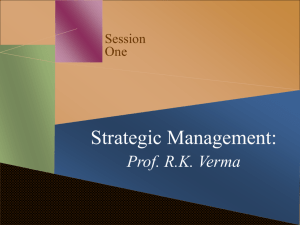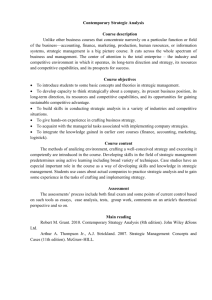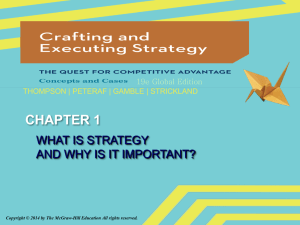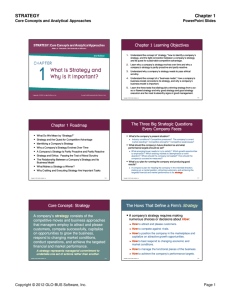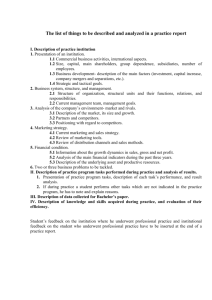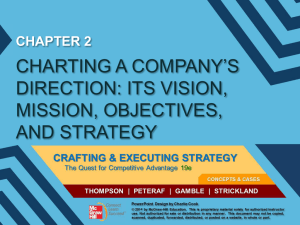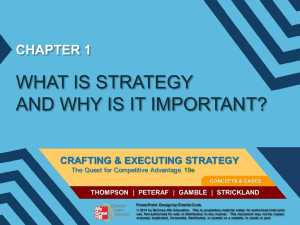Lecture 1:
advertisement
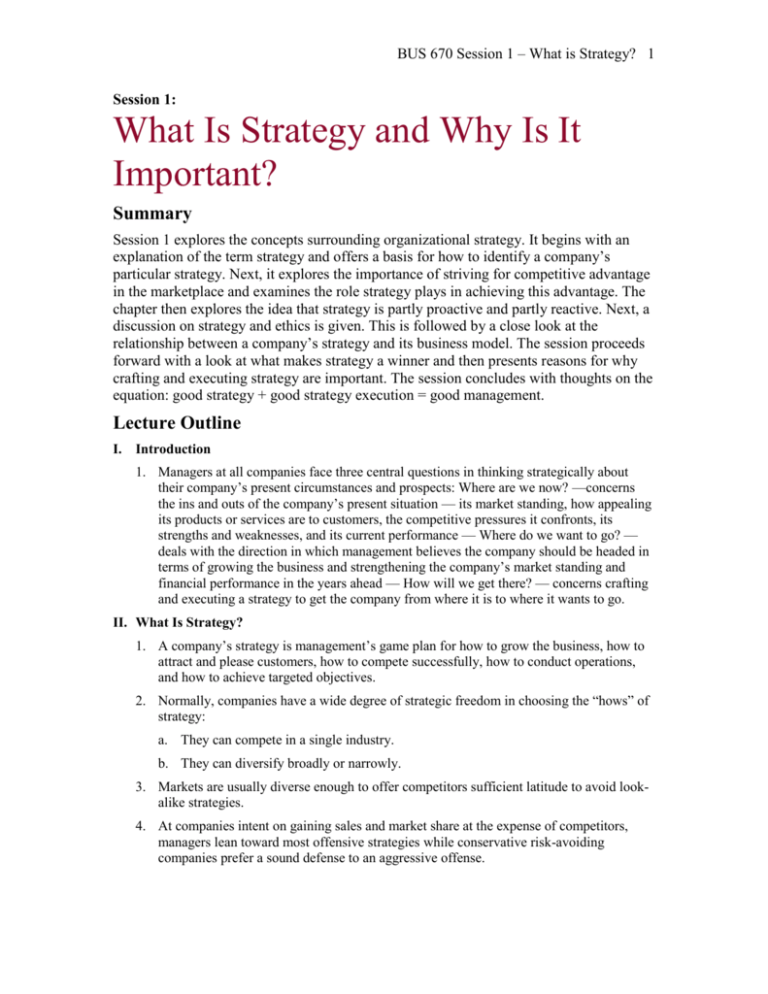
BUS 670 Session 1 – What is Strategy? 1 Session 1: What Is Strategy and Why Is It Important? Summary Session 1 explores the concepts surrounding organizational strategy. It begins with an explanation of the term strategy and offers a basis for how to identify a company’s particular strategy. Next, it explores the importance of striving for competitive advantage in the marketplace and examines the role strategy plays in achieving this advantage. The chapter then explores the idea that strategy is partly proactive and partly reactive. Next, a discussion on strategy and ethics is given. This is followed by a close look at the relationship between a company’s strategy and its business model. The session proceeds forward with a look at what makes strategy a winner and then presents reasons for why crafting and executing strategy are important. The session concludes with thoughts on the equation: good strategy + good strategy execution = good management. Lecture Outline I. Introduction 1. Managers at all companies face three central questions in thinking strategically about their company’s present circumstances and prospects: Where are we now? —concerns the ins and outs of the company’s present situation — its market standing, how appealing its products or services are to customers, the competitive pressures it confronts, its strengths and weaknesses, and its current performance — Where do we want to go? — deals with the direction in which management believes the company should be headed in terms of growing the business and strengthening the company’s market standing and financial performance in the years ahead — How will we get there? — concerns crafting and executing a strategy to get the company from where it is to where it wants to go. II. What Is Strategy? 1. A company’s strategy is management’s game plan for how to grow the business, how to attract and please customers, how to compete successfully, how to conduct operations, and how to achieve targeted objectives. 2. Normally, companies have a wide degree of strategic freedom in choosing the “hows” of strategy: a. They can compete in a single industry. b. They can diversify broadly or narrowly. 3. Markets are usually diverse enough to offer competitors sufficient latitude to avoid lookalike strategies. 4. At companies intent on gaining sales and market share at the expense of competitors, managers lean toward most offensive strategies while conservative risk-avoiding companies prefer a sound defense to an aggressive offense. BUS 670 Session 1 – What is Strategy? 2 5. There is no shortage of opportunity to fashion a strategy that tightly fits a company’s own particular situation and that is discernibly different from the strategies of rivals. 6. Typically, a company’s strategic choices are based partly on trial-and-error organizational learning about what has worked and what has not, partly on management’s appetite for risk taking, and partly on managerial analysis and strategic thinking about how to best proceed, given all the prevailing circumstances. A. Identifying a Company’s Strategy 1. A company’s strategy is reflected in its actions in the marketplace and the statements of senior managers about the company’s current business approaches, future plans, and efforts to strengthen its competitiveness and performance. 2. Once it is clear what to look for, the task of identifying a company’s strategy is mainly one of researching information about the company’s actions in the marketplace and business approaches. 3. To maintain the confidence of investors and Wall Street, most public companies have to be fairly open about their strategies. 4. Except for some about-to-be-launched moves and changes that remain under wraps and in the planning stage, there is usually nothing secret or mysterious about what a company’s present strategy is. B. Strategy and the Quest for Competitive Advantage 1. Generally, a company’s strategy should be aimed either at providing a product or service that is distinctive from what competitors are offering or at developing competitive capabilities that rivals cannot quite match. 2. What separates a powerful strategy from an ordinary or weak one is management’s ability to forge a series of moves, both in the marketplace and internally, that makes the company distinctive, tilts the playing field in the company’s favor by giving buyers reason to prefer its products or services, and produces a sustainable competitive advantage over rivals. CORE CONCEPT: A company achieves sustainable competitive advantage when an attractive number of buyers prefer its products or services over the offerings of competitors and when the basis for this preference is durable. 3. Four of the most frequently used strategic approaches to setting a company apart from rivals and achieving a sustainable competitive advantage are: a. Being the industry’s low-cost provider. b. Outcompeting rivals based on such differentiating features as higher quality, wider product selection, added performance, better service, more attractive styling, technological superiority, or unusually good value for the money. c. Focusing on a narrow market niche. d. Developing expertise and resource strengths that give the company competitive capabilities that rivals cannot easily imitate or trump with capabilities of their own. 4. Most companies realize that winning a durable competitive edge over rivals hinges more on building competitively valuable expertise and capabilities than it does on having a distinctive product. BUS 670 Session 1 – What is Strategy? 3 5. Company initiatives to build competencies and capabilities that rivals do not have and cannot readily match can relate to greater product innovation capabilities than rivals, better mastery of a complex technological process, expertise in defect-free manufacturing, specialized marketing and merchandising know-how, global sales and distribution capability, superior e-commerce capabilities, unique ability to deliver personalized customer service, or anything else that constitutes a competitively valuable strength in creating, producing, distributing, or marketing the company’s product or service. C. Strategy Is Partly Proactive and Partly Reactive 1. A company’s strategy is typically a blend of (1) proactive actions on the part of managers to improve the company’s market position and financial performance and (2) as-needed reactions to unanticipated developments and fresh market conditions. 2. The biggest portion of a company’s current strategy flows from previously initiated actions and business approaches that are working well enough to merit continuation and newly launched managerial initiatives to strengthen the company’s overall position and performance. This part of management’s game plan is deliberate and proactive. 3. Not every strategic move is the result of proactive plotting and deliberate management design. Things do happen that cannot be fully anticipated or planned for. 4. A portion of a company’s strategy is always developed on the fly. It comes about as a reasoned response to unforeseen developments. 5. Crafting a strategy involves stitching together a proactive/intended strategy and then adapting first one piece and then another as circumstances surrounding the company’s situation change or better options emerge – a reactive/adaptive strategy. 6. A Company’s Strategy Emerges Incrementally and Then Evolves Over Time: A company’s strategy should always be viewed as a work in progress. 7. On occasion, fine-tuning the existing strategy is not enough and major strategy shifts are called for: a. When a strategy is clearly failing and the company is facing a financial crisis b. When market conditions or buyer preferences change significantly and new opportunities arise c. When competitors do something unexpected d. When important technological breakthroughs occur 8. Some industries are more volatile than others. 9. Industry environments characterized by high-velocity change require rapid strategy adaptation. 10. Regardless of whether a company’s strategy changes gradually or swiftly, the important point is that a company’s strategy is temporary and on trial, pending new ideas for improvement from management, changing competitive conditions, and any other changes in the company’s situation CORE CONCEPT: Changing circumstances and ongoing management efforts to improve the strategy cause a company's strategy to emerge and evolve over time BUS 670 Session 1 – What is Strategy? 4 — a condition that makes the task of crafting a strategy a work in progress, not a one-time event. CORE CONCEPT: A company’s strategy is driven partly by management analysis and choice and partly by the necessity of adapting and learning by doing. 11. Crafting Strategy Calls for Good Entrepreneurship: The constantly evolving nature of a company’s situation puts a premium on management’s ability to exhibit astute entrepreneurship. 12. Masterful strategies come partly, maybe mostly, by doing things differently from competitors where it counts. 13. Good strategy making is inseparable from good business entrepreneurship. D. Strategy and Ethics: Passing the Test of Moral Scrutiny 1. In choosing among strategic alternatives, company managers are well advised to embrace actions that are aboveboard and can pass the test of moral scrutiny. 2. Crafting an ethical strategy means more than keeping a company’s strategic actions within the bounds of what is legal. 3. A strategy is ethical only if it meets two criteria: a. It does not entail actions and behaviors that cross the line from “can do” to “should not do”. b. It allows management to fulfill ethical duties to all stakeholders. 4. It is not always easy to categorize a given strategic behavior as definitely ethical or definitely unethical. Whether they are deemed ethical or unethical hinges on how high the bar is set. 5. Senior executives with strong character and ethical convictions are generally proactive in linking strategic action and ethics; they forbid the pursuit of ethically questionable business opportunities and insist all aspects of company strategy reflect high ethical standards. 6. Recent instances of corporate malfeasance, ethical lapses, and misleading or fraudulent accounting practices at Enron, WorldCom, Tyco, Adelphia, Dynergy, HealthSouth, and other companies leave no room to doubt the damage to a company’s reputation and business that can result from ethical misconduct, corporate misdeeds, and even criminal behavior on the part of company personnel. 7. There is little lasting benefit to unethical strategies and behavior and the downside risks can be substantial. III. The Relationship Between a Company’s Strategy and Its Business Model 1. Closely related to the concept of strategy is the concept of a company’s business model. CORE CONCEPT: A company’s business model deals with whether the revenuecost-profit economics of its strategy demonstrate the viability of the business enterprise as a whole. BUS 670 Session 1 – What is Strategy? 5 2. A company’s business model sets forth the economic logic of how an enterprise’s strategy can deliver value to customers at a price and cost that yields acceptable profitability. 3. A company’s business model is management’s storyline for how and why the company’s product offerings and competitive approaches will generate a revenue stream and have an associated cost structure that produces attractive earnings and return on investment. 4. The concept of a company’s business model is consequently more narrowly focused than the concept of a company’s business strategy. A company’s strategy relates broadly to its competitive initiatives and business approaches while the business model zeros in on whether the revenues and costs flowing from the strategy demonstrate business viability. IV. What Makes a Strategy a Winner? 1. Three questions can be used to test the merits of one strategy versus another and distinguish a winning strategy from a losing or mediocre strategy: a. How well does the strategy fit the company’s situation? i. To qualify as a winner, a strategy has to be well matched to industry and competitive conditions, a company’s best market opportunities, and other aspects of the enterprise’s external environment. Unless a strategy exhibits a tight ft with both the external and internal aspects of a company’s overall situation, it is likely to produce less than the best possible business results. b. Is the strategy helping the company achieve a sustainable competitive advantage? i. The bigger and more durable the competitive edge that a strategy helps build, the more powerful and appealing it is. c. Is the strategy resulting in better company performance? i. Two kinds of performance improvements tell the most about the caliber of a company’s strategy: (1) gains in profitability and financial strength and (2) gains in the company’s competitive strength and market standing. 2. Strategies that come up short on one or more of the above questions are plainly less appealing than strategies passing all three test questions with flying colors. CORE CONCEPT: A winning strategy must fit the enterprise’s external and internal situation, build sustainable competitive advantage, and improve company performance. 3. Other criteria for judging the merits of a particular strategy include internal consistency and unity among all the pieces of strategy, the degree of risk the strategy poses as compared to alternative strategies, and the degree to which it is flexible and adaptable to changing circumstances. V. Why are Crafting and Executing Strategy Important? 1. Crafting and executing strategy are top priority managerial tasks for two very big reasons: BUS 670 Session 1 – What is Strategy? 6 a. There is a compelling need for managers to proactively shape or craft how the company’s business will be conducted. b. A strategy-focused organization is more likely to be a strong bottom-line performer. A. Good Strategy + Good Strategy Execution = Good Management 1. Crafting and executing strategy are core management functions. 2. Among all the things managers do, nothing affects a company’s ultimate success or failure more fundamentally than how well its management team charts the company’s direction, develops competitively effective strategic moves and business approaches, and pursues what needs to be done internally to produce good day-to-day strategy execution and operating excellence. 3. Good strategy and good strategy execution are the most trustworthy signs of good management. 4. The better conceived a company’s strategy and the more competently it is executed, the more likely it is that the company will be a standout performer in the marketplace. CORE CONCEPT: Excellent execution of an excellent strategy is the best test of managerial excellence – and the most reliable recipe for turning companies into standout performers.
